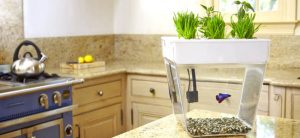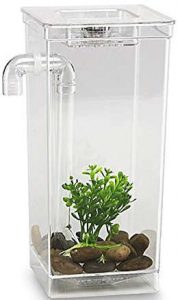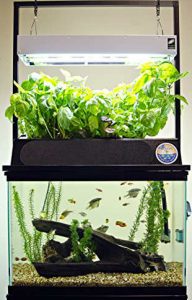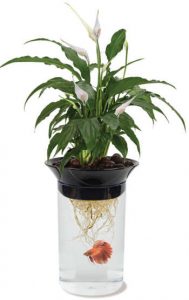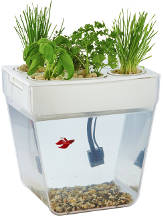 |
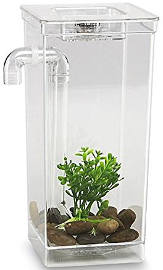 |
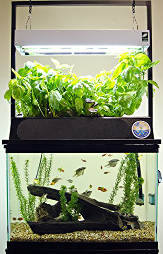 |
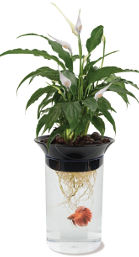 |
| Back To The Roots | My Fun Fish Tank | ECO-Cycle Aquaponics Kit | Penn-Plax Aquaponic Betta Tank |
| Solid Glass Design Included Pump Included Seeds |
Plastic Casing Low Cost Gravity Based |
Supports Large Tanks Strong Lights Included Pump LED Light For The Tank |
Compact Substrate Included No Pump Required |
| 7.5″ base, 8″ x 12″ x 11.75″ | 10″ x 5″ x 5″ | 24″ x 12″ x 20″ | 3″ x 3″ x 8.6″ |
| Price: $$ | Price: $ | Price: $$$ | Price: $ |
| View On Amazon | View On Amazon | View On Amazon | View On Amazon |
Maintaining our in home aquariums can take up a large part of our day. Sure you could simply remove all of your fish and give the tank a through scrub rather than regular maintenance but this actually hurts the environment you are trying to create. To keep the tank going long term consistent action must be taken, and what better tool could there be than the tank itself?
When you find the best self cleaning fish tank that suits your home the work needed to house fish, frogs and inverts are cut back dramatically. Unfortunately there are far too many aquariums springing up that are far from self cleaning and actually cause more work than a plain tank.
The majority of the self cleaning fish tank designs are plant based, with a few that focus on unique suction designs. Most of the latter have failed but personally I’ve found one that works perfectly.
What Makes The Best Self Cleaning Fish Tank?
First of all the design has to look good. While this may seem vain or snobby if the tank looks bad we probably wouldn’t even want it no matter how well it works. That brings us to the second point, functionality. Just as design, if the functionality doesn’t work the tank is of no real use to us. Of those that do work it’s a question of how well they work.
The third and final condition is the size of the tank. Because self cleaning fish tank designs are hard to come by it is also understandable they have some limitations. Specifically plant based self cleaning fish tanks will not be too large, as plants can only absorb so much of the waters nitrates(the final product of fish waste.) Finding a balance between size and effectiveness is our goal here. After plenty of testing and returning we have found the best self cleaning aquariums on the market.
Back To The Roots Self Cleaning Fish Tank
This tank features the most popular form of automatic cleaning in aquariums today.
As fish waste, along with any extra food they missed, breaks down into elements that are harmful to fish it is pushed to the plants roots via the pump. As the water passes by the roots the waste is slowly absorbed into the plants, keeping them well fed while simultaneously cleaning the aquariums water. This is the base idea for most of the plant based self cleaning aquariums.
What makes this tank so special is the design. Five individual plants are allowed to grow in their own section, each of witch has an equal amount of water flow. This creates a more healthy environment for the plants and allows the tank to be even lower maintenance. After all if the tank was not keeping the plants alive they would not be able to keep the aquarium water clean.
Before any of this happens we must first discuss the breakdown of the fish food and waste. This is called the nitrogen cycle and has three steps. As the waste is broken down it becomes a highly toxic ammonia. This is then broken down by beneficial bacteria into still toxic nitrites. A lot of good that is right? Well the final step is even more beneficial bacteria breaking the nitrites down into nitrates, a slightly annoying chemical that is toxic in very high quantities. This will probably raise two questions in your mind:
Where Do I Get This Bacteria?
Normally you would need to cycle your fish tank for months. This is done by feeding an empty tank the same amount you would feed normally. Thankfully the Back to the Roots self cleaning fish tank comes fully stocked with beneficial bacteria in its garden.
What About The Nitrates?
While plants do not take in toxic ammonia, they do love nitrates. It is actually better to give your plants water full of the waste produced by fish as the nutrients help the plants growth dramatically. Simply put the fish feed the plants which in turn clean for the fish.

The seeds provided with the tank are quick to grow and safe from even the least green thumb owners. Strong indoor lighting is more than enough to grow the plants, but some extra sunlight can really accelerate the growth. This is a trade off! Placing the tank in direct sunlight makes algae much more likely to appear. However when the plants grow faster they also need more nutrients and therefor clean faster.
It’s a catch 22. Personally mine sits on the window seal with a black back attached to the tank. This prevents most of the light from getting into the tank while the plants are free to get all the light they need. Again direct indoor lighting will have the plants grow just fine, so where you put the tank is entirely up to you. Speaking of anywhere
The Tank Is Silent
If you have ever had an aquarium before you’re likely already used to the constant hum of normal mechanized filtration and aeration. The tank in my bedroom cost me twice what the living room tank did as it had to be more quiet. Thankfully when I added this little tank the noise level did not increase. In fact I had to check the water pump myself as I thought it was not even on.
The pump was in fact pushing water to the plants, it is just a quiet pump. Add in the fact that the plants are your filtration and the tank turns to be one of the most silent tanks with a full set of equipment built right in.
My Fun Fish Tank Self Cleaning Aquarium
The Fun Fish Tank Self Cleaning Aquarium is one of the cheapest options available. It features a sturdy plastic design that houses a special outlet on the side of the tank. As you add new, clean water to the tank the older water is pushed out through the tube that reaches to the bottom of the tank. Essentially this means to perform water changes you only need to add the new water. Simply place something to catch the old water and you’re finished. Simple design.
A lot of people are probably thinking “there’s no way this could possibly work.” I thought that myself. In fact many of the tanks that were like this design failed. The siphons would get blocked or the water would just overflow at the top. This tank however actually worked perfectly and pushed out the old dirty water. To confirm this i used my water testing kit on both the tank and the extracted water. The results clearly showed that the new water was much cleaner than the older water.
How Does It Work?
When you add your new, treated water to the tank the water level rises. as the water level rises so will the water level in the faucet. As water begins to pour out this creates a siphon effect. Until the water has gone below the level of the faucet water will continue to be pulled from the bottom of the tank through the siphon and out of the tank. In essence you could imagine it similar to a hole on the side of the tank, except that it pulls the water from the bottom. Unless you are pouring your water from several feet above then you will almost exclusively drain the old water before the newer water mixes in.
Before you worry that the siphon may harm your fish I will inform you that is not the case. When testing this tank I housed a Betta fish inside. They are notorious for being unable to handle almost any level of water movement. Even while pouring water and draining out 100% of the old water he showed no signs of distress. Pour slowly and the fish may not even notice what’s happening.
Problems
The design of the tank does have a few limitations. For starters you may not use fine substrates such as sand or crushed coral. These are too small and will plug up the siphon. Gravel and rocks are more suitable for this self cleaning fish tank.
Secondly is the size. Coming in at half a gallon not many fish are able to be housed in this tank. Small species of Betta fish and guppies are the primary inhabitants of this tank. If you opt in for a tropical fish you will need a mini heater for this tank. Due to its size I try to only use cold water fish.
As the tank is not a plant based tank and comes with no beneficial bacteria, water changers are necessary. Again this is the main point of the tank, as water changes only take about a minute and remove the toxins just as quickly. Still it is something to keep in mind. Over long vacations you will need to either bring the tank with you or have someone come along and take care of the fish. Remember to instruct them on using treated water and to not over feed. While this self cleaning fish tank can easily remove the toxins produced over time, excess feeding will dirty the water far more frequently than owners are willing to perform water changes.
ECO-Cycle Aquaponics Kit
Ok lets put the mini tanks aside for a minute. The ECO-Cycle Aquaponics Kit is designed to fit aquariums with a footprint of 24″ by 12″. Typically this will be a 20 gallon aquarium, but there are specially made tanks with the same footprint.
As I’m sure you have noticed this is a lot bigger than the other self cleaning fish tanks. For more aquarists this is the dream tank. A decent size combined with an easy to use automatic cleaning system.
The plants are fed in the same way the back to the roots tank worked. A pump send water to the plants roots, allowing the plants to pull harmful nitrates from the water and supply oxygen in turn. This keeps the tank much cleaner for long periods of time. Personally I still performed water changed once a month even though my water tests came back 0 ammonia 0 nitrites 10-20 nitrates. If you’re new to the hobby that may sound like a lot of nitrates. Simply put once you have fish in the tank it becomes impossible to have 0 nitrates. To do so you would need to put the fish in 100% new water and test the water before any food or waste is added to the tank. Some may even be stored on the decorations and I know first hand many filters can trap in nitrates too. So for this tank to keep the nitrates to so low after an entire month with several fish inside is beyond impressive.
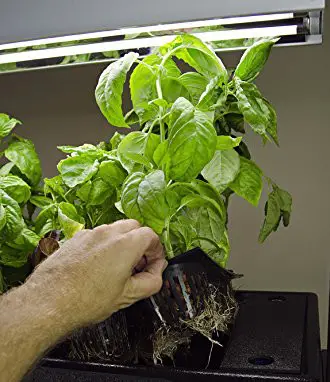
Plants
When I was using this tank something struck me about a month in. I had plants on my tank. I had completely forgotten they were growing there and yet they had grown nice and healthy. It was at this point that I found more useful plants that could actually be eaten and slowly replaced each plant in the hood. During my next harvest I was surprised how much better than store quality my tank had produced. Additionally there was much more than my previous back to the roots tank had given me. If you want to grow efficiently chives and strawberries make great choices, as a couple of these go a long way. Green beans are fine too but you need a whole lot of them. The plants where small harvests make a big deal are always my top choices. Now if only I had some fish to grill with them…
If you are a bit of the DIY kind of person you will be happy to know that the plants rest in net pots. Rather than have all your plants divided up, you can opt for greater efficiency and create your own large plant bed. By removing the walls your space goes up a surprising amount, letting the roots roam a bit more and allows for more even spacing. If you want to grow different plants however the included net pots may be exactly what you needed.
Filtration
Back to the details of the system. Included with the tank are the pre-filter sponge, bio-filter brick, water pump and hose. No surprise extra pieces needed for this self cleaning fish tank. The sponge and brick take care of two important parts of aquarium filtration. First off the pre-filter sponge catches all the large debris, keeping those random chunks of fish waste tucked away until they can be broken down into plant food. Next comes the bio-filter brick. This is what will house your beneficial bacteria. Combined with your plants the bacteria helps maintain the perfect aquatic environment. Simply feeding the fish will keep everything going.
Maintenance
My main problem with the tank is that when it does require cleaning it proves a bit more challenging than other tanks. The only real reasons I have ad to clean are algae growth from too much light and a long forgotten filter pad (those things can become absolute nitrate traps!) The hood is a bit difficult to clean through, meaning I had an easier time removing it all together, cleaning the tank and then placing it back on. Not much work since this should only be done every say 3-6 months but it is still something you should know.
When replacing the bulb be sure to use a T5 bulb, preferably one that is meant to grow plants. Without the proper light to grow said plants your tank loses out on the self cleaning fish tank title and becomes a tank with dirt on the top. The light for the tank itself is an LED light, meaning they should last for over 5 years. Should anything happen to the LED you can contact the manufacturer and they’ll get your problem sorted out.
As the tank is a large 20 gallon you will likely need an aquarium heater. The hood features a small slot in the back to allow your cord to fit in easily, ensuring this is not a problem. If however you choose to house a fish who likes cold water such as the gold fish the heater is not needed.
Penn-Plax Aquaponic Betta Tank
This is a small tank that is primarily used to house small Betta fish. If you wish to house a different kind of fish you will need to improvise your own form of aeration.
With that part out of the way we can discuss a little bit about this tank. Coming in at half a gallon the Penn-Plax aquaponic self cleaning fish tank is a low cost choice for those looking to add a fish to their home. Most of the dimensions are used in height, making this tank mostly suitable to Betta fish. Located atop the tank is the single pot where you can plant any leafy green plant. Try to avoid plants with high needs as they will only be supplied by a single fish.
As displayed in the picture to the right there is no form of water movement in this tank. The roots of the plant are simply allowed to fall into the tank and absorb the nutrients they need. As this happens the plant takes away the harmful toxins produced by fish waste and excess food. Additionally they release oxygen into the water which helps compensate for the lack of water movement.
The reason Betta fish are able to use this low amount of oxygenated water is because they have the ability to breath from the waters surface. Most fish do not have this ability and would end up running into the plant while getting oxygen from the surface, harming them until they succumb to illness.
